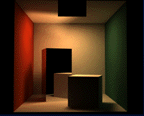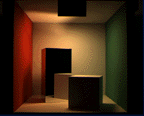


Global Illumination-Cornell Box

|

|
|
|
|
|
The Cornell Box was constructed at the Program of Computer Graphics to facilitate developing the fundamental physical underpinnings of computer-based rendering. Researchers recognized early on that lighting models for computer graphics were short-term approaches geared toward the hardware and software limitations of the day. As our ability to both calculate and display images has improved, we can take advantage of improved theoretical and physical models to approach our goal of photorealistic rendering. Professors Donald Greenberg and Kenneth Torrance have worked together for over ten years to build both a light measurement laboratory and the computer algorithms to accurately model global illumination in a synthetic environment.
|
[FOO95]Sing-Choong Foo and Kenneth Torrance, "Equipment Acquisition for the Light Measurement Laboratory of the Cornell Program of Computer Graphics," PCG-95-5, Program of Computer Graphics Technical Report, Cornell University, September 30, 1995.
[TORR95]Kenneth Torrance, Suthipong Wangpattanasirikul, and Sing-Choong Foo, "A User's Guide to the OL750 Spectral Reflectance Measurement System," PCG-95-1, Program of Computer Graphics Technical Report, Cornell University, February 1, 1995.
| Home | Research | Outreach | Televideo | Admin | Education |